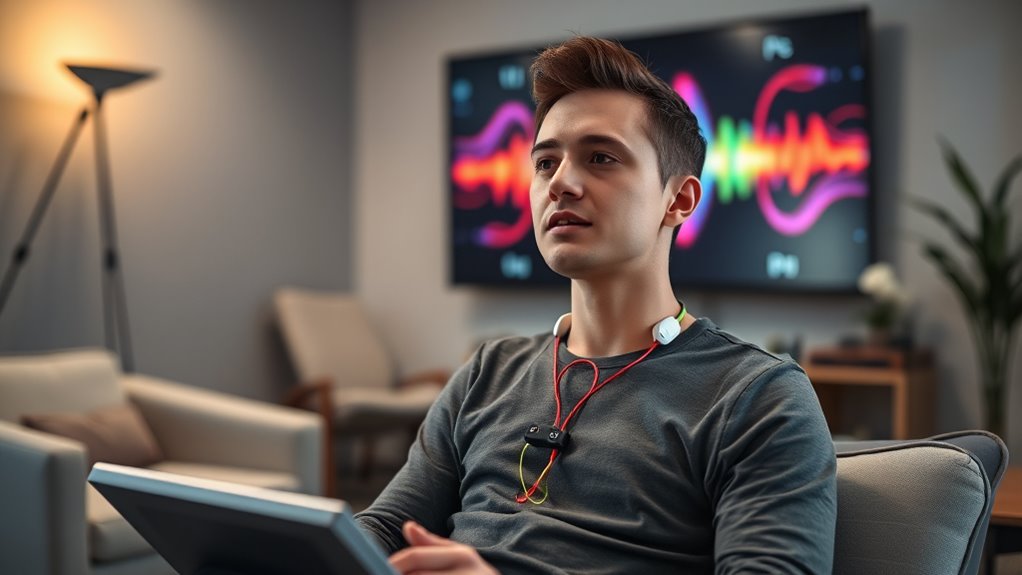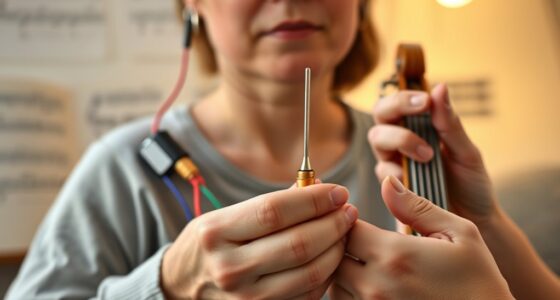Biofeedback devices support voice therapy in the deaf community by offering real-time visual cues for pitch, muscle tension, and vocal habits. They help you understand and control your voice more precisely, even if hearing is limited. These tools make complex vocal concepts more tangible, encouraging better muscle relaxation and pitch modulation. If you keep exploring, you’ll discover how these devices can transform your vocal practice and progress effectively.
Key Takeaways
- Biofeedback devices visualize pitch and muscle tension, aiding deaf users in understanding and controlling vocal parameters effectively.
- They provide real-time visual cues to improve vocal pitch, expression, and clarity despite hearing limitations.
- Devices monitor muscle tension to reduce vocal strain, promoting healthier voice use for deaf individuals.
- Biofeedback tools accelerate vocal skill development by offering immediate, tangible feedback for practice and mastery.
- They enable at-home, measurable voice practice, supporting progress tracking and reinforcement of healthy vocal habits.

Biofeedback devices are transforming voice therapy by providing real-time, objective feedback that helps you understand and control your vocal habits. For individuals in the deaf community, these devices offer a powerful way to visualize aspects of voice that are often hidden or difficult to perceive without auditory cues. One key area these devices target is voice pitch, which is essential for expressing emotion, intent, and clarity. With biofeedback, you can see how your pitch varies during speech, allowing you to make precise adjustments. This immediate visual information helps you develop awareness of your vocal range and encourages steady, intentional pitch control, even if you have limited hearing.
Another critical aspect these devices address is muscle tension, a common factor affecting vocal quality and comfort. Excess muscle tension in the larynx or neck can cause strain, fatigue, or a strained voice. Using biofeedback, you can monitor tension levels and learn to relax or engage muscles appropriately. This not only improves voice quality but also reduces the physical discomfort often associated with vocal strain. As you see real-time data on muscle activity, you become more conscious of how tension influences your voice and can practice techniques to ease unnecessary strain.
The active, visual feedback from biofeedback devices makes it easier for you to grasp complex vocal concepts. Instead of relying solely on auditory cues or subjective judgment, you have concrete data to guide your practice. For example, if your voice pitch is too high or too low, the device will show you the deviation instantly, prompting you to adjust your vocal effort accordingly. Similarly, if muscle tension spikes, you’ll receive immediate cues to relax those muscles. This instant awareness accelerates learning and helps you develop better vocal habits more quickly than traditional methods.
Moreover, biofeedback devices empower you to take control of your voice therapy outside of clinical sessions. You can practice at home with confidence, knowing that you’re working on measurable, specific goals. Consistent use reinforces good habits and helps you track your progress over time. For the deaf community, where auditory feedback may be limited, these visual and tactile cues are invaluable in bridging the gap between effort and outcome. They make abstract concepts of pitch and tension tangible, giving you a clear understanding of how to modulate your voice effectively.
Additionally, advancements in home theater projectors technology have inspired innovative ways to incorporate visual feedback into therapy environments, making practice more engaging and accessible.
Frequently Asked Questions
How Do Biofeedback Devices Adapt for Different Levels of Hearing Impairment?
You might wonder how biofeedback devices adapt for different hearing impairments. These devices use personalized calibration to tailor feedback based on your specific hearing level, ensuring effective therapy. Adaptive technology plays a key role, adjusting the feedback intensity and type in real-time as you improve. This customization helps you achieve better voice control, making the therapy more accessible and effective, regardless of your degree of hearing impairment.
Are Biofeedback Devices Suitable for Children in Voice Therapy?
You’ll find biofeedback devices incredibly effective for children’s voice therapy, like having a superpower at your fingertips. They boost pediatric engagement by making therapy interactive and fun. Plus, device customization guarantees each child’s unique needs are met, fostering better progress. These tools are safe, adaptable, and designed specifically for young users, making them a fantastic choice for helping children develop confident, healthy voices through engaging, tailored therapy sessions.
What Is the Cost Range of Biofeedback Devices for Voice Therapy?
You’re wondering about the cost range of biofeedback devices for voice therapy. Device affordability varies widely, depending on features and technology. Pricing variability can be significant, with basic models starting around a few hundred dollars, while advanced systems may cost over a thousand dollars. Consider your budget and therapy needs carefully to find a device that offers the right balance of affordability and functionality for effective voice therapy.
How Long Does It Typically Take to See Improvements Using These Devices?
You’re likely wondering about the progress timeline and therapy effectiveness with biofeedback devices. Typically, you might start noticing improvements within a few weeks, but it varies based on individual goals and consistency. Regular use accelerates progress, and many users find these devices highly effective for improving voice control. Stick with the therapy plan, and you’ll see steady progress, making the effort well worth it over time.
Can Biofeedback Devices Be Used Independently Without Therapist Supervision?
You can use biofeedback devices independently, but be aware of self-monitoring benefits and device calibration challenges. Self monitoring helps you track progress and stay motivated, while proper calibration ensures accurate feedback. Without therapist supervision, you might miss subtle issues or misinterpret signals. It’s best to start with professional guidance to learn correct usage and calibration, then continue practicing independently to reinforce your voice therapy goals effectively.
Conclusion
Imagine trying to find your voice in a crowded room—without feedback, it’s nearly impossible. Biofeedback devices act like a guiding lighthouse, helping you navigate your voice therapy journey. For members of the deaf community, these tools turn silent struggles into clear progress, much like a musician tuning their instrument until it sings perfectly. Embracing this technology can transform silence into sound, empowering you to communicate confidently and connect more deeply with others.











